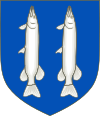|
Mancini family
  The House of Mancini was the name of one of the oldest families of Roman nobility.[1] Their titles and fiefs were numerous: Duke of Nevers and Donzy, Prince of Vergagne and of the Holy Roman Empire with the treatment of Serene Highness, French Peer, Spanish Grandee, Marquis of Fusignano, Count of Montefortino, Viscount of Clamecy, Baron of Tardello, Tumminii and Ogliastro, Lord of Claye-Souilly, Roman noble and Venetian patrician. They were knights of the Order of the Golden Fleece, of the Order of the Holy Spirit, of the Order of Saint Michael, of the Sovereign Order of Saint John of Jerusalem and many more. The humanist Marco Antonio Altieri (1457–1537) includes them in Li Nuptiali, an important collection of news about Rome in the 16th century. The family was granted the Honneurs de la Cour of France. OriginsOf Roman origin, the family has thousand-year roots in Italy, and traditionally asserts a line of descent from the gens Hostilia, whose line took the surname Mancinus, all the way back to Lucius Hostilius Mancinus who was consul in 145 BC and a commander of the Roman fleet during the Third Punic War. History  Naples lineThe Naples line was descended from Domenico Nicola Mancini who was nominated Marquis of Fusignano by the Prince Francesco of Este, son of the Duke Alfonso of Este, and he moved to the Kingdom of Naples in 1527; Domenico Nicola III, 5° Marquis of Fusignano gained the title of Count Mancini in 1745 by the Pope Benedict XIV; it had as most important member the Count Pasquale Stanislao Mancini (1817–1888), 8° Marquis of Fusignano, illustrious jurist, writer and three times Minister of The Kingdom of Italy (public education, justice and foreign affairs). Various lines derive from the Naples line, among which the noble Federico Mancini (London 1951), Aldo Mancini (Foggia 1938), Count of Montefortino and knight of the Sovereign Order of Saint John of Jerusalem, and of the Teutonic Order, and the son Giorgio Mancini (Rome 1974), and the San Vittore line (from the hamlet of San Vittore del Lazio where the family got wide terrains and properties) founded by the Count Antonio Mancini in 1800 with his representative Count Adriano Fulvio Mario Mancini (Rome 1952) and the son Count Federico Adriano Mario La Longa Mancini (Rome 1979). Mancini of RomeThe Mancini family was called de Lucij (or simply Lucij)[2][3] in Rome for the fishes on its coat of arms. Many of the members were "Conservatori all'Urbe". The first known member of the family is Lucio Mancini who lived in 990. In the centuries the family had various lines that thrived with nobility everywhere, particularly at Fermo where the first memories go back to 1160 giving to the city Priori, Consoli, Gonfalonieri and Dottori, but the most important are the Sicily line and the Nevers line. Sicily lineThe Sicily line: a) was descended from Giacomo Mancini who moved to Sicily in 1256 to run away at Vitelleschi persecutions; Barons of Tardello, Tumminii and Ogliastro were descended from him. This line was extinguished in the 17th century. b) was descended from Francesco Mancini, consanguineous of the Cardinal Giulio Mazzarino, who moved to Catania in the 17th century as Attorney-General of the Prince Marco Antonio Colonna and his wife Isabella Gioeni. Mancini family flourished in Catania in the following centuries, so that the Town-Council dedicated streets and squares to Mancini's family. At present the surname of the family is Mancini de Lucij. Nevers LineThe Nevers line: was illustrated by many eminent people:
The family coat of arms inspired the heraldry of the French commune of Liernais. San Vittore lineCollateral line of the illustrious and old Mancini family, subline of the Naples line, initiated in the 19th century by the Count Antonio Filippo Luigi (1824–1890), first lieutenant of the Neapolitan Army. The son Giuseppe Alessandro Luigi (1852–1903), Belle-Epoque dandy, married donna Maria Antonietta Marinelli (1862–1911), daughter of the noble Vittorio Leonardo of the marquesses Marinelli, in 1882; they had seven children along which Carlo Alberto Antonio (1883–1940), horse owner who married a noblewoman of german descent, Maria Concetta Cassone Simeoni-Wrbna, patrician of Benevento (1886–1965) in 1911. They had Antonio Eugenio Andrea (1915–1990), officer of the Italian Army, he was aide-de-camp of Marshal Rodolfo Graziani in 1938, and during the Second World War fought in the VIII Army Corps on the Greek-Albanian battlefront; in 1943 he was caught by the Germans in Yugoslavia and he was confined at Hohenstein in Saxony, but he escaped; then he got the Military Cross. In 1951 he married noble Giulia de Dominicis (1930–1988), daughter of the noble Michele Alfonso de Dominicis (1907–1960), Commander of the Order of Merit of the Republic. His son Count Adriano Fulvio Mario Mancini (1952)[6] Arabian horse breeder and entrepreneur on the advertising industry, member of the Società Genealogica Italiana, Commander of the Sovereign Order of Saint John of Jerusalem. Notable buildings
Sources
Notes
External links
|
Portal di Ensiklopedia Dunia